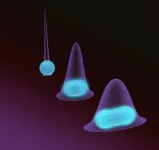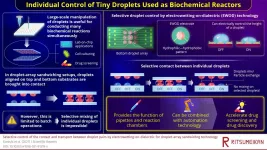Quantum particles: Pulled and compressed
2021-07-07
(Press-News.org) Very recently, researchers led by Markus Aspelmeyer at the University of Vienna and Lukas Novotny at ETH Zurich cooled a glass nanoparticle into the quantum regime for the first time. To do this, the particle is deprived of its kinetic energy with the help of lasers. What remains are movements, so-called quantum fluctuations, which no longer follow the laws of classical physics but those of quantum physics. The glass sphere with which this has been achieved is significantly smaller than a grain of sand, but still consists of several hundred million atoms. In contrast to the microscopic world of photons and atoms, nanoparticles provide an insight into the quantum nature of macroscopic objects. In collaboration with experimental physicist Markus Aspelmeyer, a team of theoretical physicists led by Oriol Romero-Isart of the University of Innsbruck and the Institute of Quantum Optics and Quantum Information of the Austrian Academy of Sciences is now proposing a way to harness the quantum properties of nanoparticles for various applications.
Briefly delocalized
"While atoms in the motional ground state bounce around over distances larger than the size of the atom, the motion of macroscopic objects in the ground state is very, very small," explain Talitha Weiss and Marc Roda-Llordes from the Innsbruck team. "The quantum fluctuations of nanoparticles are smaller than the diameter of an atom." To take advantage of the quantum nature of nanoparticles, the wave function of the particles must be greatly expanded. In the Innsbruck quantum physicists' scheme, nanoparticles are trapped in optical fields and cooled to the ground state. By rhythmically changing these fields, the particles now succeed in briefly delocalizing over exponentially larger distances. "Even the smallest perturbations may destroy the coherence of the particles, which is why by changing the optical potentials, we only briefly pull apart the wave function of the particles and then immediately compress it again," explains Oriol Romero-Isart. By repeatedly changing the potential, the quantum properties of the nanoparticle can thus be harnessed.
Many applications
With the new technique, the macroscopic quantum properties can be studied in more detail. It also turns out that this state is very sensitive to static forces. Thus, the method could enable highly sensitive instruments that can be used to determine forces such as gravity very precisely. Using two particles expanded and compressed simultaneously by this method, it would also be possible to entangle them via a weak interaction and explore entirely new areas of the macroscopic quantum world.
Together with other proposals, the new concept forms the basis for the ERC Synergy Grant project Q-Xtreme, which was granted last year. In this project, the research groups of Markus Aspelmeyer and Oriol Romero-Isart, together with Lukas Novotny and Romain Quidant of ETH Zurich, are pushing one of the most fundamental principles of quantum physics to the extreme limit by positioning a solid body of billions of atoms in two places at the same time.
INFORMATION:
[Attachments] See images for this press release:

ELSE PRESS RELEASES FROM THIS DATE:
2021-07-07
DURHAM, N.C. -- You dash into a convenience store for a quick snack, spot an apple and reach for a candy bar instead. Poor self-control may not be the only factor behind your choice, new research suggests. That's because our brains process taste information first, before factoring in health information, according to new research from Duke University.
"We spend billions of dollars every year on diet products, yet most people fail when they attempt to diet," said study co-author Scott Huettel, a professor of psychology and neuroscience at Duke. "Taste seems to have an advantage that sets us up for failure."
"For many individuals, health information enters the decision process ...
2021-07-07
Injecting sulphur into the stratosphere to reduce solar radiation and stop the Greenland ice cap from melting. An interesting scenario, but not without risks. Climatologists from the University of Liège have looked into the matter and have tested one of the scenarios put forward using the MAR climate model developed at the University of Liège. The results are mixed and have been published in the journal The Cryosphere.
The Greenland ice sheet will lose mass at an accelerated rate throughout the 21st century, with a direct link between anthropogenic greenhouse gas emissions and the extent of Greenland's mass loss. To combat this phenomenon, and therefore global warming, it is essential to reduce ...
2021-07-07
ITHACA, N.Y. - An interdisciplinary team of Cornell and Harvard University researchers developed a machine learning tool to parse quantum matter and make crucial distinctions in the data, an approach that will help scientists unravel the most confounding phenomena in the subatomic realm.
The Cornell-led project's paper, "Correlator Convolutional Neural Networks as an Interpretable Architecture for Image-like Quantum Matter Data," published June 23 in Nature Communications. The lead author is doctoral student Cole Miles.
The Cornell team was led by Eun-Ah Kim, professor of physics in the College of Arts and Sciences, who partnered with Kilian Weinberger, associate professor of computing and information science in the Cornell Ann S. ...
2021-07-07
When you insist you're not racist, you may unwittingly be sending the opposite message.
That's the conclusion of a new study* by three Berkeley Haas researchers who conducted experiments with white participants claiming to hold egalitarian views. After asking them to write statements explaining why they weren't prejudiced against Black people, they found that other white people could nevertheless gauge the writers' underlying prejudice.
"Americans almost universally espouse egalitarianism and wish to see themselves as non-biased, yet racial prejudice persists," says Berkeley ...
2021-07-07
A genetic map of an aggressive childhood brain tumour called medulloblastoma has helped researchers identify a new generation anti-cancer drug that can be repurposed as an effective treatment for the disease.
This international collaboration, led by researchers from The University of Queensland's (UQ) Diamantina Institute and WEHI in Melbourne, could give parents hope in the fight against the most common and fatal brain cancer in children.
UQ lead researcher Dr Laura Genovesi said the team had mapped the genetics of these aggressive brain tumours for five years to find new pathways that existing drugs could potentially target.
"These are drugs already approved for other diseases or cancers but have never been tested in paediatric brain tumours," Dr Genovesi ...
2021-07-07
ST. LOUIS -- In the United States, low-income and minority students are completing college at low rates compared to higher-income and majority peers -- a detriment to reducing economic inequality. Double-dose algebra could be a solution, according to a new study published in roceedings of the National Academy of Sciences of the United States of America (PNAS).
The paper, "Effects of Double-Dose Algebra on College Persistence and Degree Attainment," is the culmination of a series of studies that followed two cohorts of ninth-grade students over a period of 12 years in the Chicago Public Schools (CPS) where double-dose algebra ...
2021-07-07
Miniaturization is rapidly reshaping the field of biochemistry, with emerging technologies such as microfluidics and "lab-on-a-chip" devices taking the world by storm. Chemical reactions that were normally conducted in flasks and tubes can now be carried out within tiny water droplets not larger than a few millionths of a liter. Particularly, in droplet-array sandwiching techniques, such tiny droplets are orderly laid out on two parallel flat surfaces opposite to each other. By bringing the top surface close enough to the bottom one, each top droplet makes contact with the opposite bottom droplet, exchanging chemicals and transferring particles or even cells. In quite a literal way, these droplets can act as small reaction ...
2021-07-07
BUFFALO, N.Y -- Children who eat slower are less likely to be extroverted and impulsive, according to a new study co-led by the University at Buffalo and Children's Hospital of Philadelphia.
The research, which sought to uncover the relationship between temperament and eating behaviors in early childhood, also found that kids who were highly responsive to external food cues (the urge to eat when food is seen, smelled or tasted) were more likely to experience frustration and discomfort and have difficulties self-soothing.
These findings are critical because faster eating and greater responsiveness to food cues have been linked to obesity risk in children, ...
2021-07-07
A new study examining why young South Asian heart attack patients have more adverse outcomes found this patient population was often obese, used tobacco products, and had a family history of heart disease or risk factors that could have been prevented, monitored for or treated before heart attacks happen. The study will be presented at the ACC Asia 2021 Together with SCS 32nd Annual Scientific Meeting Virtual being held July 9-11, 2021.
"South Asians tend to have multiple co-morbidities including diabetes and obesity at younger ages which is different from the white population," said Salik ur Rehman Iqbal, ...
2021-07-07
Research conducted at Cruzeiro do Sul University in São Paulo, Brazil, can contribute to earlier diagnosis of diabetic neuropathy, a disorder characterized by damage to peripheral nerves, with symptoms such as pain and paresthesia (pricking, burning and numbness), mainly in the legs and feet.
In the study, a group led by Professor Paulo Barbosa de Freitas Júnior measured grip force in diabetic patients while they were holding and handling objects. The results were compared with data for healthy subjects and patients with other neurological diseases, such as multiple sclerosis, Parkinson’s, and carpal tunnel syndrome (pain, numbness and tingling in the hand and arm caused by a pinched nerve in the wrist).
Freitas and his ...
LAST 30 PRESS RELEASES:
[Press-News.org] Quantum particles: Pulled and compressed




